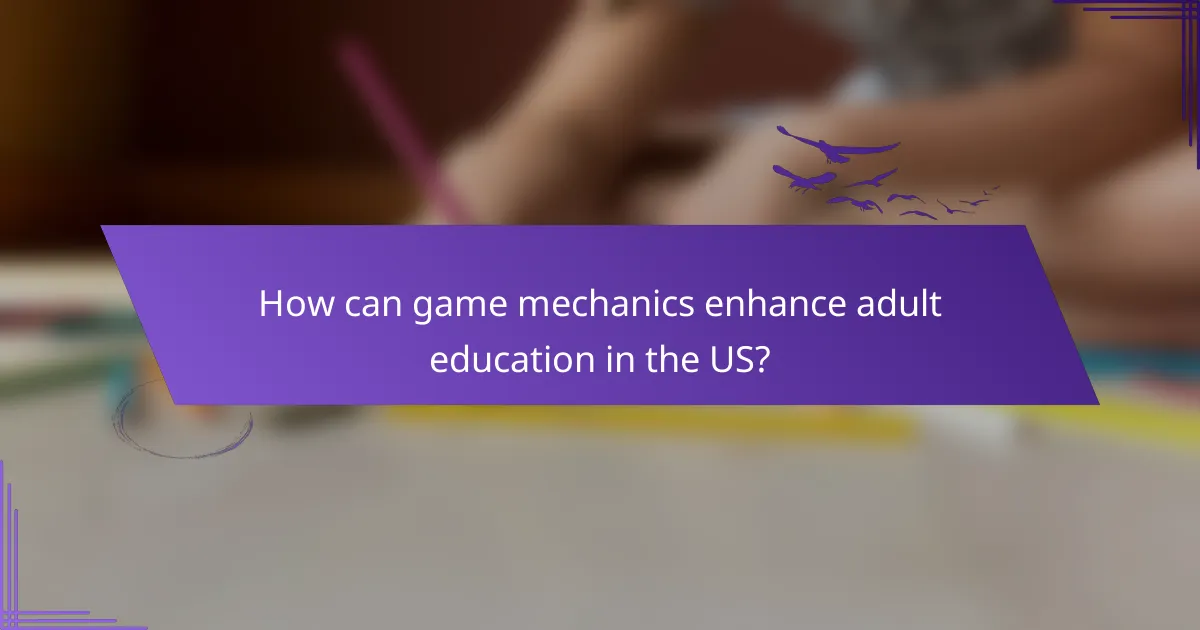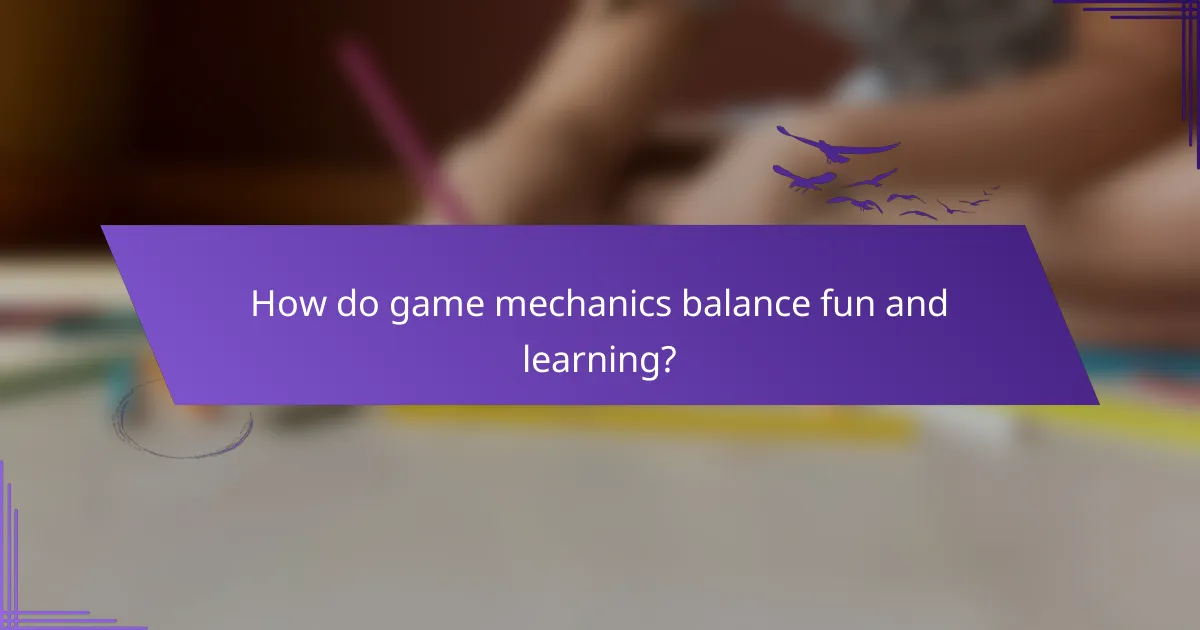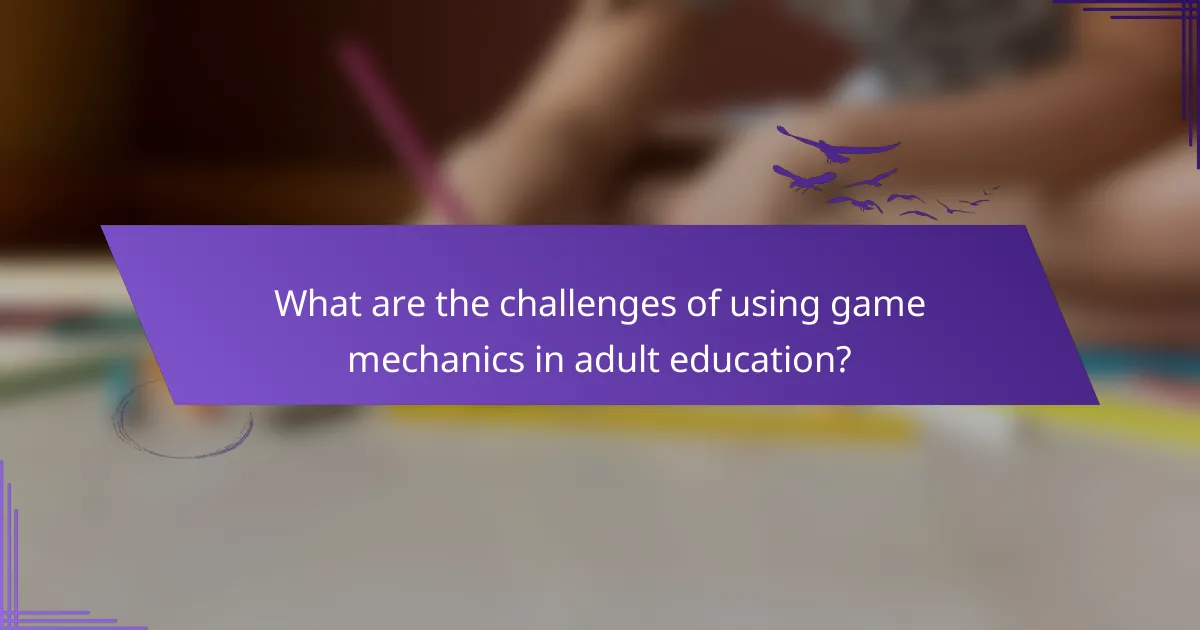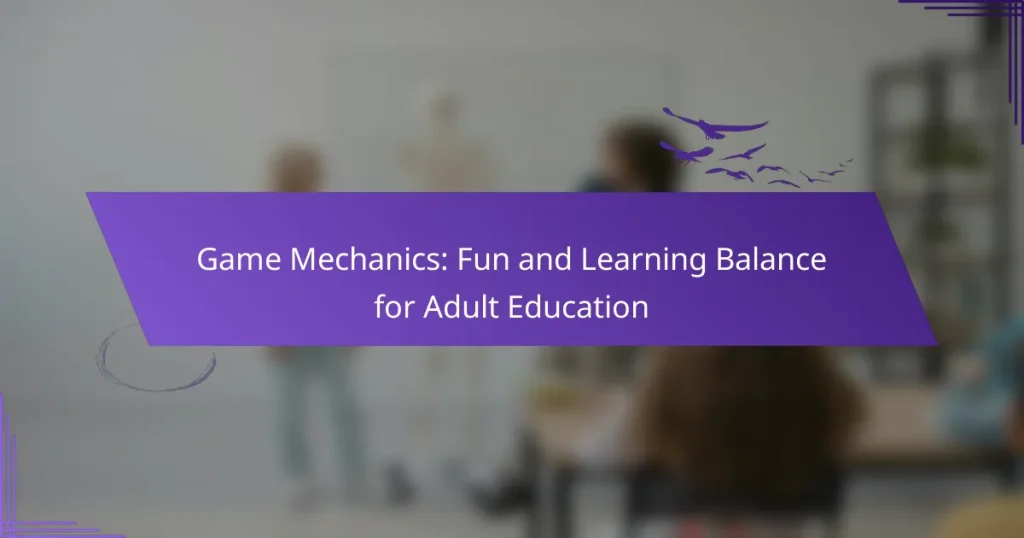Game mechanics play a crucial role in enhancing adult education by transforming traditional learning into a more engaging and interactive experience. By integrating elements such as challenges, rewards, and competition, educational programs can motivate learners, fostering a dynamic environment that promotes both enjoyment and effective knowledge acquisition.

How can game mechanics enhance adult education in the US?
Game mechanics can significantly enhance adult education in the US by making learning more engaging and interactive. By incorporating elements like challenges, rewards, and competition, educational programs can motivate learners and improve their overall experience.
Increased engagement through gamification
Gamification increases engagement by integrating game-like elements into educational content. This can include point systems, badges, and leaderboards that encourage participation and foster a sense of achievement. For example, a course might reward learners with points for completing modules, which can then be displayed on a leaderboard.
To effectively use gamification, educators should ensure that the game elements align with learning objectives. Overemphasis on competition can lead to stress, so it’s essential to balance competitive aspects with collaborative opportunities.
Improved retention with interactive elements
Interactive elements, such as quizzes and simulations, can significantly improve knowledge retention among adult learners. These activities require active participation, which helps reinforce concepts and skills. For instance, a simulation that mimics real-world scenarios allows learners to apply their knowledge in a practical context.
Educators should incorporate a variety of interactive elements to cater to different learning styles. Using a mix of visual, auditory, and kinesthetic activities can enhance engagement and retention, making the learning experience more effective.
Real-time feedback and assessment
Real-time feedback is a crucial component of game mechanics in adult education, allowing learners to understand their progress instantly. Immediate responses to quizzes or activities help identify areas for improvement and reinforce learning. For example, an online course might provide instant feedback on quiz answers, enabling learners to correct mistakes and grasp concepts more thoroughly.
To maximize the benefits of real-time feedback, educators should ensure that assessments are frequent and varied. Regular check-ins can help maintain motivation and provide learners with a clear understanding of their performance, guiding them toward their educational goals.

What are effective game mechanics for online courses?
Effective game mechanics for online courses enhance engagement and facilitate learning by incorporating elements that motivate and challenge learners. These mechanics can include point systems, leaderboards, and quests, which create a dynamic educational environment that encourages participation and skill application.
Point systems for motivation
Point systems reward learners for completing tasks, participating in discussions, or achieving specific milestones. This gamification element fosters motivation by providing tangible recognition of progress, which can lead to increased engagement. For example, awarding points for each module completed can encourage learners to stay on track.
To implement a point system effectively, consider setting clear criteria for earning points and ensuring that the rewards are meaningful. Avoid overwhelming learners with too many point categories; instead, focus on a few key actions that align with course objectives.
Leaderboards for competition
Leaderboards introduce a competitive aspect to online courses, allowing learners to see their ranking relative to peers. This can stimulate motivation as individuals strive to improve their position. However, it’s essential to maintain a balance; overly competitive environments can discourage some learners, particularly those who may struggle.
To create an effective leaderboard, consider using a tiered system that recognizes various levels of achievement. For instance, you could have separate rankings for different skill levels or categories, ensuring that all learners feel included and motivated to improve.
Quests and challenges for skill application
Quests and challenges provide learners with opportunities to apply their knowledge in practical scenarios. These tasks can simulate real-world situations, making learning more relevant and engaging. For example, a quest might involve solving a case study that requires applying concepts learned in the course.
When designing quests, ensure they are clearly defined and achievable within a reasonable timeframe. Incorporating elements like time limits or collaborative challenges can further enhance engagement. Additionally, providing feedback on completed quests helps learners understand their progress and areas for improvement.

How do game mechanics balance fun and learning?
Game mechanics balance fun and learning by integrating engaging elements that motivate learners while facilitating knowledge acquisition. This approach ensures that educational experiences are enjoyable, enhancing retention and application of skills.
Incorporating narrative elements
Narrative elements can significantly enhance the learning experience by providing context and emotional engagement. When learners are immersed in a story, they are more likely to connect with the material, making it memorable and relevant.
For instance, using a storyline where learners assume roles in a historical event can help them understand complex concepts while keeping them entertained. This method not only fosters engagement but also encourages critical thinking as learners navigate through challenges within the narrative.
Adaptive learning paths for personalization
Adaptive learning paths tailor educational experiences to individual needs, allowing learners to progress at their own pace. By assessing a learner’s strengths and weaknesses, these paths can adjust content and difficulty, ensuring that each user is appropriately challenged.
For example, a platform might offer different levels of quizzes based on previous performance, enabling learners to focus on areas where they need improvement. This personalized approach can lead to higher motivation and better outcomes, as learners feel more in control of their education.
Reward systems aligned with educational goals
Effective reward systems can motivate learners by recognizing achievements and encouraging continued effort. These systems should be directly linked to educational objectives, reinforcing the desired behaviors and outcomes.
Common rewards include points, badges, or unlocking new content, which can enhance engagement. However, it’s crucial to ensure that rewards do not overshadow the learning process; they should complement the educational goals rather than distract from them.

What are the prerequisites for implementing game mechanics?
To effectively implement game mechanics in adult education, understanding the target audience and establishing clear educational goals are essential. These prerequisites ensure that the game elements enhance learning rather than distract from it.
Understanding learner demographics
Recognizing the demographics of your learners is crucial for tailoring game mechanics to their preferences and needs. Factors such as age, educational background, and technological proficiency can significantly influence engagement levels and learning outcomes.
For instance, younger adults may respond better to fast-paced, competitive games, while older learners might prefer collaborative, slower-paced activities. Conducting surveys or focus groups can provide insights into what types of game mechanics resonate with your audience.
Defining clear educational objectives
Establishing clear educational objectives is vital for integrating game mechanics effectively. These objectives should align with the overall learning goals and specify what learners should achieve through the gaming experience.
For example, if the goal is to improve critical thinking skills, the game mechanics should encourage problem-solving and decision-making. Use the SMART criteria—Specific, Measurable, Achievable, Relevant, Time-bound—to formulate these objectives, ensuring they guide the design of the game elements.

What are the challenges of using game mechanics in adult education?
Using game mechanics in adult education presents several challenges, including resistance from traditional educators, the need to maintain educational rigor, and potential technical limitations of course platforms. Addressing these issues is crucial for effectively integrating gamification into adult learning environments.
Resistance to change from traditional methods
Many educators are accustomed to conventional teaching methods and may resist adopting game mechanics. This resistance can stem from a lack of understanding of gamification benefits or fear of losing control over the learning process.
To overcome this, provide training sessions that demonstrate successful case studies where game mechanics enhanced learning outcomes. Highlighting the positive impact on engagement and retention can help ease concerns.
Balancing fun with educational rigor
Finding the right balance between fun and educational rigor is essential when implementing game mechanics. While engaging activities can boost motivation, they must also align with learning objectives to ensure that educational content is not overshadowed by entertainment.
Consider using a framework to evaluate activities, ensuring they meet both engagement and educational criteria. For example, a scoring system can reward learners for achieving specific learning milestones while still providing enjoyable experiences.
Technical limitations in course platforms
Technical limitations of course platforms can hinder the effective application of game mechanics. Not all learning management systems (LMS) support gamification features, which can restrict the types of activities and assessments that can be implemented.
Before designing a course, assess the capabilities of your LMS. If necessary, explore alternative platforms that offer robust gamification tools or consider integrating external applications that can complement your existing system.

What are the emerging trends in gamified adult education?
Emerging trends in gamified adult education focus on integrating game mechanics into learning environments to enhance engagement and retention. This approach leverages elements like competition, rewards, and interactive challenges to create a more dynamic educational experience.
Incorporation of Technology
Technology plays a crucial role in gamified adult education, with platforms utilizing virtual and augmented reality to create immersive learning experiences. These tools allow learners to engage with content in a hands-on manner, making complex subjects more accessible and enjoyable.
For instance, language learning apps often use gamification to encourage daily practice through challenges and rewards, significantly increasing user retention rates. The use of mobile devices also facilitates learning on-the-go, catering to the busy schedules of adult learners.
Focus on Collaborative Learning
Collaborative learning is increasingly emphasized in gamified adult education, encouraging teamwork and peer interaction. This trend fosters a sense of community among learners, which can enhance motivation and accountability.
Examples include group challenges where participants must work together to solve problems or complete tasks. Such collaborative activities not only improve social skills but also allow learners to benefit from diverse perspectives and experiences.
Personalization of Learning Experiences
Personalization is a key trend in gamified adult education, allowing learners to tailor their educational journeys according to their interests and skill levels. This approach enhances engagement by providing relevant content and challenges that resonate with individual learners.
For example, adaptive learning platforms can adjust difficulty levels based on user performance, ensuring that learners are consistently challenged without feeling overwhelmed. This customization helps maintain motivation and promotes a deeper understanding of the material.
Data-Driven Insights
Utilizing data analytics is becoming essential in gamified adult education, enabling educators to track progress and identify areas for improvement. By analyzing learner interactions and outcomes, educators can refine their approaches and enhance the overall effectiveness of their programs.
For instance, platforms may provide dashboards that display learner performance metrics, allowing instructors to offer targeted support. This data-driven approach ensures that educational strategies are continuously optimized to meet the needs of adult learners.


